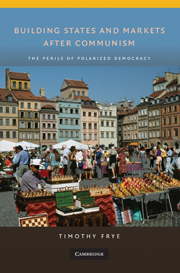Book contents
- Frontmatter
- Contents
- List of Tables and Figures
- Acknowledgments
- Introduction
- 1 The Political Logic of Economic and Institutional Reform
- 2 Political Polarization and Economic Inequality
- 3 The Pace and Consistency of Reform
- 4 Political Polarization and Economic Growth
- 5 Political Polarization and Policy Instability: The View from the Firm
- 6 Nationalism and Endogenous Polarization
- 7 Russia: Polarization, Autocracy, and Reform
- 8 Bulgaria: Polarization, Democracy, and Reform
- 9 Poland: Robust Democracy and Rapid Reform
- 10 Uzbekistan: Autocracy and Inconsistent Gradualism
- 11 Conclusion
- References
- Index
- Titles in the series
7 - Russia: Polarization, Autocracy, and Reform
Published online by Cambridge University Press: 05 June 2012
- Frontmatter
- Contents
- List of Tables and Figures
- Acknowledgments
- Introduction
- 1 The Political Logic of Economic and Institutional Reform
- 2 Political Polarization and Economic Inequality
- 3 The Pace and Consistency of Reform
- 4 Political Polarization and Economic Growth
- 5 Political Polarization and Policy Instability: The View from the Firm
- 6 Nationalism and Endogenous Polarization
- 7 Russia: Polarization, Autocracy, and Reform
- 8 Bulgaria: Polarization, Democracy, and Reform
- 9 Poland: Robust Democracy and Rapid Reform
- 10 Uzbekistan: Autocracy and Inconsistent Gradualism
- 11 Conclusion
- References
- Index
- Titles in the series
Summary
Fourteen years ago, Moscow's summer was filled with sheer exuberance.…On the night of Aug. 22, 1991, several construction cranes and a crowd of about 50,000 determined people gathered in central Moscow to seal that promise of something better than Soviet misery. In front of the sinister KGB building, workers rocked, cracked and then toppled the formidable statue of Feliks Dzerzhinsky. This is the man who in 1917 founded the Cheka, the “Extraordinary Commission” that terrorized the nation with the arrests and brutal executions that became known as the Red Terror.…The statue of “Iron Feliks” was relegated to an undistinguished patch of land behind the New Tretyakov Gallery.…Earlier this month, with little fanfare but plenty of dreary symbolism, Dzerzhinsky was returned to a position of honor in central Moscow. It is not the same statue, and not the same site. Instead, Iron Feliks is a few blocks away at the Interior Ministry, his bronze bust back on a pedestal in the new Russian society.
International Herald Tribune, November 20, 2005This chapter links variations in economic policy choices in Russia in the period under study to changes in elite partisanship, polarization, and democracy. The 1990s witnessed a highly polarized struggle for power in a setting of relatively democratic politics under a right executive. These conditions contributed to a mix of inconsistent reform, including rapid privatization, slow institutional reforms, and steep cuts in transfers. From 2000 to 2003, political polarization declined, politics remained relatively democratic, and an economically centrist president came to power.
- Type
- Chapter
- Information
- Building States and Markets after CommunismThe Perils of Polarized Democracy, pp. 168 - 191Publisher: Cambridge University PressPrint publication year: 2010

